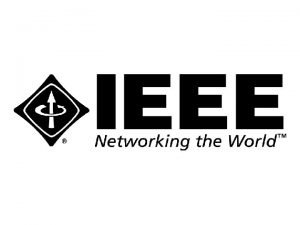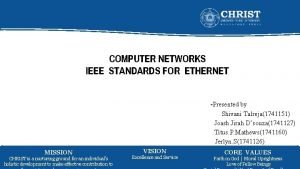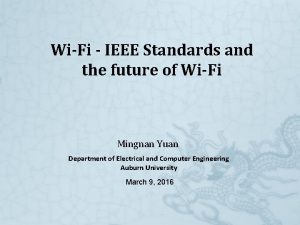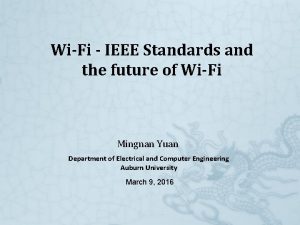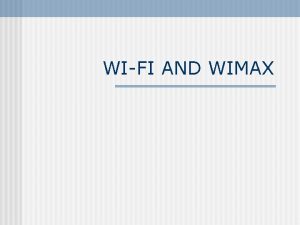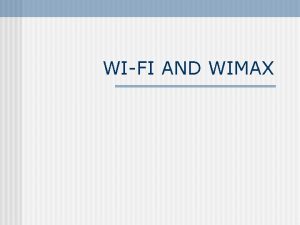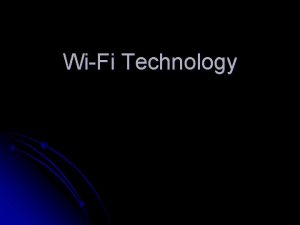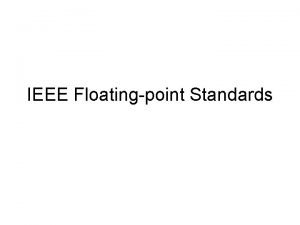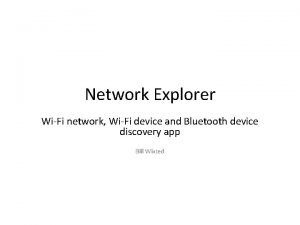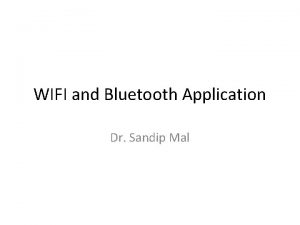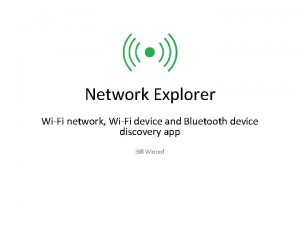WiFi IEEE Standards and the future of WiFi










![References [1] B. L, 2006, Achieving optimal performance in IEEE 802. 11 wireless LANs References [1] B. L, 2006, Achieving optimal performance in IEEE 802. 11 wireless LANs](https://slidetodoc.com/presentation_image_h/bf15426606b7e672f464c75826d545b0/image-11.jpg)
- Slides: 11

Wi-Fi - IEEE Standards and the future of Wi-Fi Mingnan Yuan Department of Electrical and Computer Engineering Auburn University March 9, 2016

Outline • History of IEEE 802. 11 WLAN • Very high throughput signal field • Multiple-input and multiple-output • BEAMFORMING • Future Techniques

History of IEEE 802. 11 WLAN 802. 11 defined only the data rate of 1 or 2 Mb/s operated at 2. 4 GHz band using. IEEE expanded on the original 802. 11 standard in July 1999, creating the 802. 11 b specification. 802. 11 b supports bandwidth up to 11 Mbps. 802. 11 b uses the same unregulated radio signaling frequency (2. 4 GHz) as the original 802. 11 standard. 802. 11 g attempts to combine the best of both 802. 11 a and 802. 11 b. 802. 11 g supports bandwidth up to 54 Mbps, and it uses the 2. 4 GHz frequency for greater range. Industry standards groups ratified 802. 11 n in 2009 with specifications providing for up to 300 Mbps of network bandwidth. 802. 11 ac bandwidth rated up to 1300 Mbps on the 5 GHz band.

History of IEEE 802. 11 WLAN 802. 11 ac chooses a mixed-mode format with new portion. This amendments enable an efficient preamble design for MIMO operation. After 20 m sec long legacy portion of the preamble, more control signals are defined in very high throughput signal field (VHT-SIG) for 11 ac.

Very high throughput signal field

Multiple-input and multiple-output • MIMO is a method for multiplying the capacity of a radio link using multiple transmit and receive antennas to exploit multipath propagation. MIMO has become an essential element of wireless communication standards. • With a new MU-MIMO feature introduced in 802. 11 ac, the VHT-SIG should indicate necessary information for recipients to process MUMIMO packets.

Multi-user MIMO transmissions

BEAMFORMING Beam-forming is one of advanced MIMO techniques to enhance throughput significantly. Antenna coordination for directional beams is enabled with an aid of channel state information (CSI) feedback, and thus it is essential to efficiently deliver such information from a beam-formee to a beam-former.

PERFORMANCE OF BEAMFORMING

Future Techniques • Sub-band orthogonal multiplexing division multiple access (OFDMA) • UPLINK MU-MIMO • Full duplex transmission
![References 1 B L 2006 Achieving optimal performance in IEEE 802 11 wireless LANs References [1] B. L, 2006, Achieving optimal performance in IEEE 802. 11 wireless LANs](https://slidetodoc.com/presentation_image_h/bf15426606b7e672f464c75826d545b0/image-11.jpg)
References [1] B. L, 2006, Achieving optimal performance in IEEE 802. 11 wireless LANs with the combination of link adaptation and adaptive backoff [2] Xu Bao, 2014, Protocol Design and Capacity Analysis in Hybrid Network of Visible Light Communication and OFDMA Systems [3] Joonsuk Kim, 2015, 802. 11 WLAN: History and New Enabling MIMO Techniques for Next Generation Standards [4] Moussa Ayyash, 2016, Coexistence of Wi. Fi and Li. Fi towards 5 G: Concepts, Opportunities, and Challenges [5] Nam Nguyen, 2015, A Novel WLAN Roaming Decision and Selection Scheme for Mobile Data Offloading [6] Sharad S Wagha, 2015, Performance Evaluation of IEEE 802. 15. 4 Protocol Under Coexistence of Wi-Fi 802. 11 b
 Future perfect time
Future perfect time Future perfect simple vs future perfect continuous
Future perfect simple vs future perfect continuous Ieee software engineering standards
Ieee software engineering standards Bluetooth ieee
Bluetooth ieee Ieee standards in computer networks
Ieee standards in computer networks Hard standards and soft standards examples
Hard standards and soft standards examples Future continuous future perfect exercises
Future continuous future perfect exercises Past continuous diagram
Past continuous diagram Future plans and finished future actions
Future plans and finished future actions Budoucí čas will
Budoucí čas will 1 2 3 kondicional u engleskom jeziku
1 2 3 kondicional u engleskom jeziku Perfect future
Perfect future



